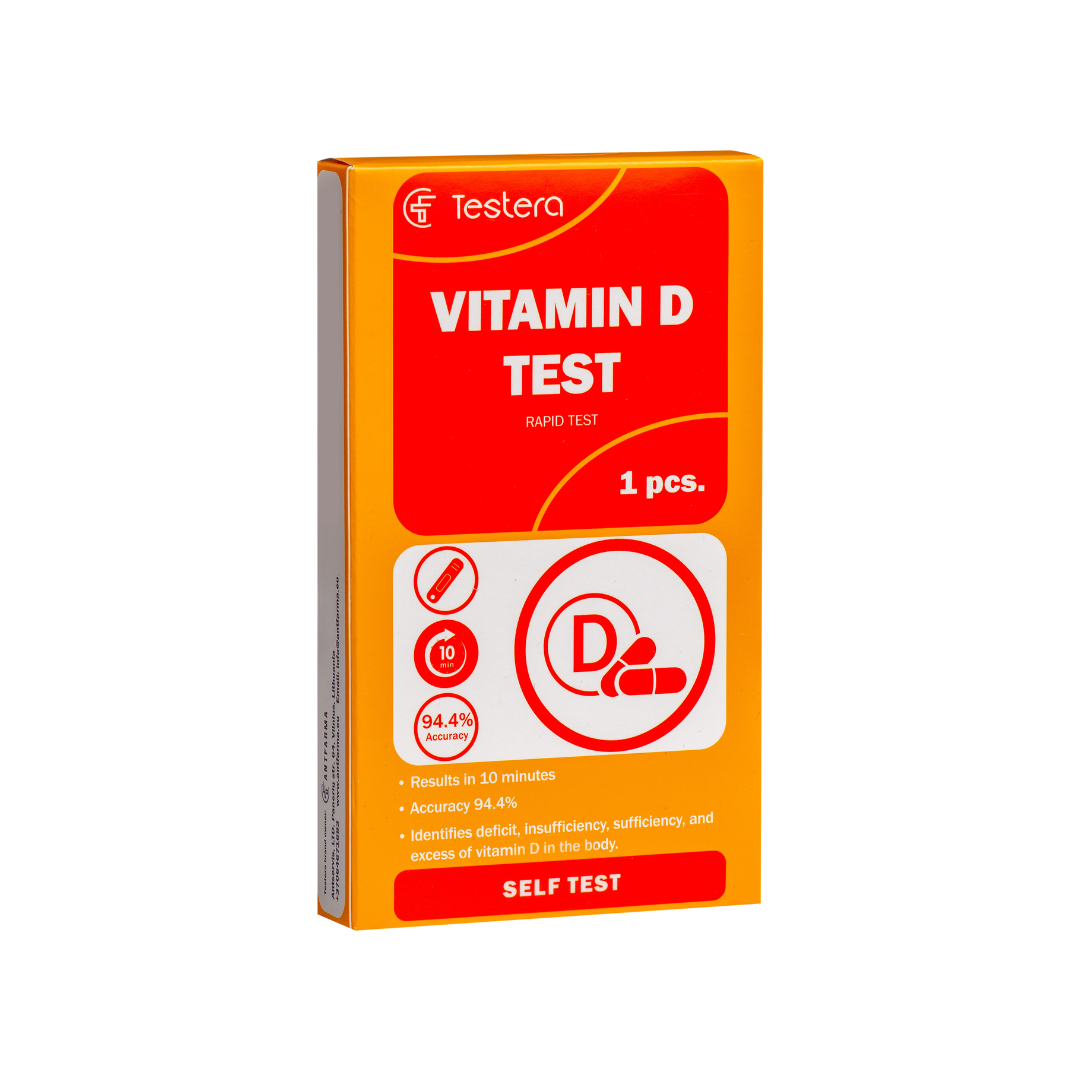Home / Testera tests / Vitamin D test

Vitamin D test
The test is used to determine the level of vitamin D in a person's blood. It detects vitamin D deficiency, insufficiency, sufficiency and excess in the body.

Accuracy 94,4 %
Sensitivity - 95 %
Specificity - 93,3 %

Results in 10 minutes

The sample is finger blood.
The problem
Vitamin D promotes the absorption of calcium and phosphorus in the intestines, which is essential for healthy bones, teeth and general bodily functions.
- Test cassette
- Buffer
- Lancet
- Alcohol-soaked tampon
- Capillary dripper
- Package leaflet
- Colour card
- Wash your hands with soap and rinse with clean warm water.
- Keep the bag at room temperature before opening it. Open the bag, remove the test cartridge and place it on a clean and flat surface. Perform the test within one hour, but best results are obtained if the test is performed immediately after opening the foil bag. Remove the dropper, the buffer bottle, the lancet and the alcohol-soaked swab and place them near the test cassette.
- Carefully detach and discard the detached lancet cap.
- Wipe the tip of the middle or ring finger with an alcohol-soaked swab to prepare the puncture site. Allow the stitches to heal.
- Press the lancet with the side from which the cap was removed; the tip automatically and securely retracts after use. Sweep your hand towards the tip of the middle or ring finger to be pierced without touching the puncture site.
- Keeping your arm lowered, massage the punctured fingertip to expose a drop of blood. Wipe off the first drop of blood.
- Without pressing on the head of the capillary dropper, attach it to the blood that has been squeezed. The capillarity of the capillary allows the blood to enter the capillary dropper up to the line indicated on the capillary dropper. If the blood does not reach the indicated line, you can massage your finger again to squeeze out more blood. Avoid air bubbles.
- Squeeze the head of the dropper to transfer the blood into the sample well (S) of the cartridge.
- Wait until all the blood has dripped into the well. Unscrew the cap of the buffer bottle and add 2 drops of buffer into the well of the cartridge buffer (B), then start the timer.
- Wait for the coloured line(s) to appear. Check the results after 10 minutes. Compare the intensity of the T-line with the "Vitamin D Colour Card" provided with the kit to determine the level of vitamin D in your blood. Do not check the results after 20 min.
| 25-OH vitamin D levels | Reference range (nmol/L) | Reference range (nmol/L) | To read the results, see the Vitamin D Color Card |
| Disadvantage | 0-10 | 0-25 | Two coloured lines appear. One appears in the control area (C) and the other must be in the test area (T). The intensity of the line in the test area (T) is equal to the deficiency (0-10 ng/mL) on the colour card, indicating that the vitamin D level is deficient. |
| Insufficient | 10-30 | 25-75 | Two coloured lines appear. One appears in the control area (C) and the other should be in the test area 25-75 (T).The intensity of the line in the test area (T) is equal to the sufficient line (10-30 ng/mL) on the colour card, indicating that the vitamin D level is not sufficient. |
| Sufficient | 30-100 | 75-250 | Two coloured lines appear, one should always be in the control area (C) and a faint coloured line appears in the test area (T).The intensity of the line in the test area (T) is equal to the sufficient line (30-100 ng/mL) on the colour card, indicating that the vitamin D level is sufficient. |
| Petreklius | A single coloured line appears in the control area (C). No coloured line is visible in the test line area (T). If the result shows an excess, it is recommended to consult a doctor. |
| Not valid | The control line does not appear. The most likely reasons for the non-appearance of the reference line are insufficient sample quantity or an incorrect procedure. Revise the procedure and repeat the test with a new test. If the problem persists, discontinue use of the test kit and contact your local distributor. |
Ingredients
- Test cassette
- Buffer
- Lancet
- Alcohol-soaked tampon
- Capillary dripper
- Package leaflet
- Colour card
Instructions
- Wash your hands with soap and rinse with clean warm water.
- Keep the bag at room temperature before opening it. Open the bag, remove the test cartridge and place it on a clean and flat surface. Perform the test within one hour, but best results are obtained if the test is performed immediately after opening the foil bag. Remove the dropper, the buffer bottle, the lancet and the alcohol-soaked swab and place them near the test cassette.
- Carefully detach and discard the detached lancet cap.
- Wipe the tip of the middle or ring finger with an alcohol-soaked swab to prepare the puncture site. Allow the stitches to heal.
- Press the lancet with the side from which the cap was removed; the tip automatically and securely retracts after use. Sweep your hand towards the tip of the middle or ring finger to be pierced without touching the puncture site.
- Keeping your arm lowered, massage the punctured fingertip to expose a drop of blood. Wipe off the first drop of blood.
- Without pressing on the head of the capillary dropper, attach it to the blood that has been squeezed. The capillarity of the capillary allows the blood to enter the capillary dropper up to the line indicated on the capillary dropper. If the blood does not reach the indicated line, you can massage your finger again to squeeze out more blood. Avoid air bubbles.
- Squeeze the head of the dropper to transfer the blood into the sample well (S) of the cartridge.
- Wait until all the blood has dripped into the well. Unscrew the cap of the buffer bottle and add 2 drops of buffer into the well of the cartridge buffer (B), then start the timer.
- Wait for the coloured line(s) to appear. Check the results after 10 minutes. Compare the intensity of the T-line with the "Vitamin D Colour Card" provided with the kit to determine the level of vitamin D in your blood. Do not check the results after 20 min.
Results
| 25-OH vitamin D levels | Reference range (nmol/L) | Reference range (nmol/L) | To read the results, see the Vitamin D Color Card |
| Disadvantage | 0-10 | 0-25 | Two coloured lines appear. One appears in the control area (C) and the other must be in the test area (T). The intensity of the line in the test area (T) is equal to the deficiency (0-10 ng/mL) on the colour card, indicating that the vitamin D level is deficient. |
| Insufficient | 10-30 | 25-75 | Two coloured lines appear. One appears in the control area (C) and the other should be in the test area 25-75 (T).The intensity of the line in the test area (T) is equal to the sufficient line (10-30 ng/mL) on the colour card, indicating that the vitamin D level is not sufficient. |
| Sufficient | 30-100 | 75-250 | Two coloured lines appear, one should always be in the control area (C) and a faint coloured line appears in the test area (T).The intensity of the line in the test area (T) is equal to the sufficient line (30-100 ng/mL) on the colour card, indicating that the vitamin D level is sufficient. |
| Petreklius | A single coloured line appears in the control area (C). No coloured line is visible in the test line area (T). If the result shows an excess, it is recommended to consult a doctor. |
| Not valid | The control line does not appear. The most likely reasons for the non-appearance of the reference line are insufficient sample quantity or an incorrect procedure. Revise the procedure and repeat the test with a new test. If the problem persists, discontinue use of the test kit and contact your local distributor. |
Informative video
Instruction leaflet
You can buy this test:



















